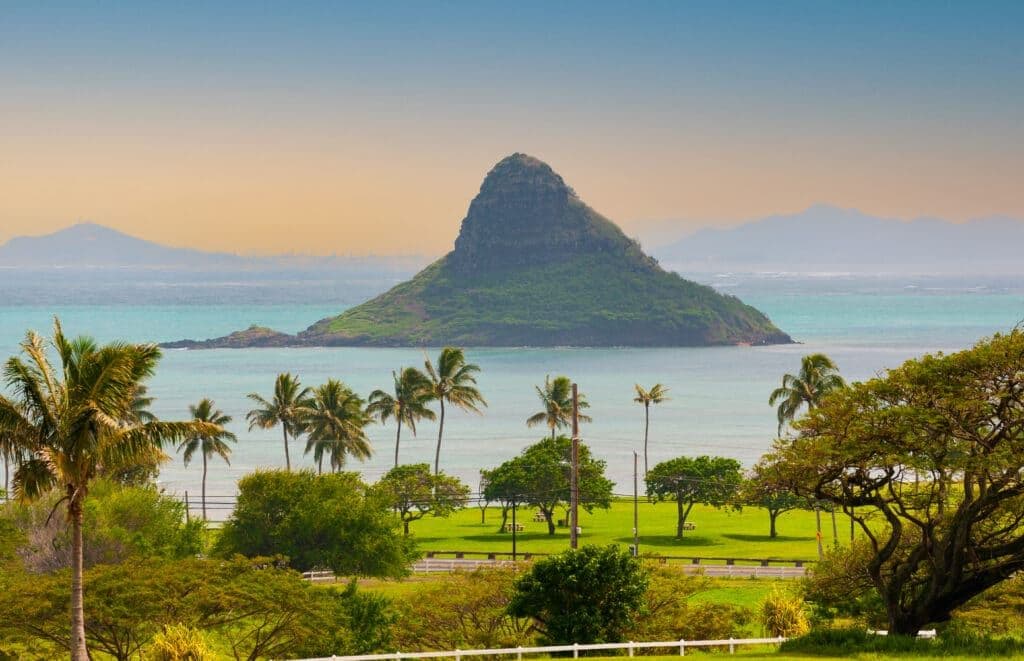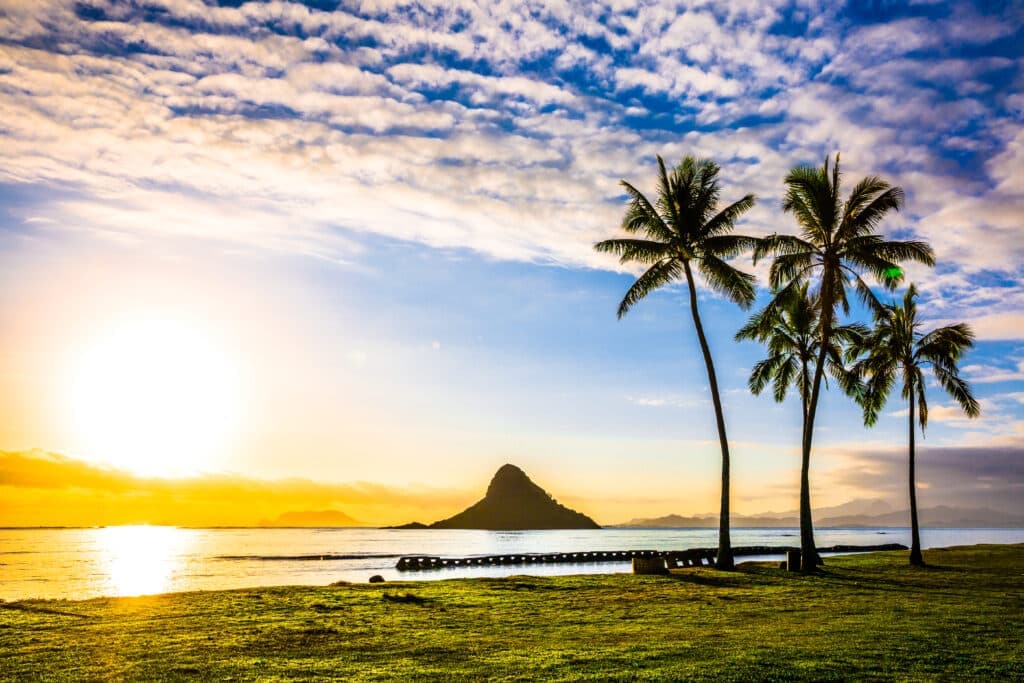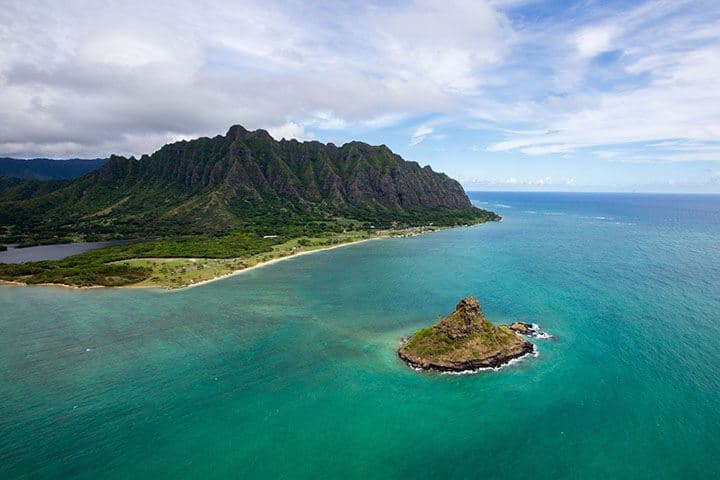By M. Kruse
Hawaiian Culture
Hiking on Oahu
Oahu
Oahu Beaches
Oahu Culture & History
Oahu Nature & Parks
Things to Do on Oahu
Off the windward coast of Oʻahu sits a small island that sparks the curiosity of nearly every traveler who sees it. With its unique shape and stunning natural beauty, Chinaman’s Hat — officially known as Mokoli’i — is a must-visit destination for those seeking travel experiences centered around hiking, kayaking, and camping in this scenic area.
Whether you’re admiring it from the shore of Kualoa Regional Park or paddling out through the waves, Chinaman’s Hat offers a mix of scenery, legend, and recreation that captures the spirit of Oʻahu’s North Shore. Chinaman’s Hat is also popular for outdoor activities like kayaking and hiking, with unique features such as the summit and Hidden Beach, making it an adventurous spot for visitors.

Chinaman’s Hat island off the east coast of Oahu (Shutterstock)
Mokoli’i Island, affectionately known as Chinaman’s Hat, is a small, picturesque islet located just off the coast of Kualoa Regional Park on Oʻahu’s windward side. This charming island is a favorite among outdoor enthusiasts and nature lovers, offering breathtaking views of the surrounding landscape, including the majestic Koʻolau Mountain Range. Its unique shape, reminiscent of a traditional Chinese hat, makes Mokoli’i Island a must-visit spot for anyone exploring Oʻahu’s natural beauty. Whether you’re gazing at it from the shore or embarking on an adventure to its peak, Mokoli’i Island promises an unforgettable experience.
Chinaman’s Hat gets its nickname from its distinct shape. From the coastline, the islet resembles the wide-brimmed conical hats worn throughout parts of Asia, much like how Diamond Head is an iconic landmark on Oahu. But its real name, Mokoli’i, means “little lizard” in Hawaiian. This basalt islet rises just 206 feet above the water and sits about 500 yards offshore from Kualoa Point.
It’s part of Kualoa Regional Park, which is steeped in history and beauty. Mokoli’i itself is protected as a seabird sanctuary and home to several native species. Mokoli’i Island holds cultural significance and is associated with local legends. While the nickname is still widely used, it’s important to know that the name “Chinaman’s Hat” can be seen as outdated. Visitors are encouraged to also recognize and use its Hawaiian name, Mokoli’i, as a gesture of respect for Hawaiian culture.
“The views of Chinaman’s Hat from Kualoa Beach Park are unreal. Perfect spot for sunrise!” —@hawaiianvibesdaily on Instagram

Sunrise from Chinaman’s Hat on Oahu, Hawaii (Shutterstock)
Like many places in Hawaiʻi, Mokoli’i has a legend behind it. According to Hawaiian mythology, the island is said to be the tail of a giant lizard, or moʻo, that was defeated by the goddess Hiʻiaka, sister of Pele, the volcano goddess. As legend goes, Hiʻiaka battled the moʻo, slicing it into pieces. Its tail landed in the ocean, creating the islet we now know as Mokoli’i. The rest of the creature’s body formed parts of the Koʻolau mountain range behind it. This tale is not just a fun story — it reflects the deep connection between Hawaiian culture and the land.
Another tale describes how the only visible part of a giant fisherman, who rests below the sea, is his big hat that sticks out above the ocean surface.
These stories often explain geological features while reinforcing respect for nature and its spiritual importance. In Hawaiian tradition, moʻo are not just reptiles — they are guardians of freshwater sources and sacred places. Some legends describe moʻo as shapeshifters who could appear as humans, especially powerful women. Hiʻiaka’s battle with the moʻo wasn’t just about brute strength — it symbolized the protection of the land and the people. Mokoliʻi, then, stands as a reminder of this cosmic struggle and a call to honor the mana (spiritual energy) of the islands.
For those interested in Hawaiian myths, check out the book “The Story of Chinaman’s Hat” by Dean Howell.
“Learning the moʻo legend before visiting Chinaman’s Hat made it feel like I was stepping into an ancient story.” — @islandroots on Twitter

Chinaman’s Hat
Chinaman’s Hat is located just offshore from Kualoa Regional Park in Kaneohe, on the east side of Oʻahu. The park’s address is: 49-479 Kamehameha Hwy, Kaneohe, HI 96744.
By Car: It’s about a 45-minute drive. Take H-1 to Likelike Highway (Route 63) or Pali Highway (Route 61), then connect to Kamehameha Highway (Route 83) along the coast. The scenic drive alone is worth the trip.
By Bus: Take Bus Route 60 from Waikīkī to Kaneohe. Then transfer to Route 55, which runs along Kamehameha Highway and stops near the park. Expect about 1.5–2 hours travel time.
Free parking is available at Kualoa Regional Park. The park is open daily from 7 a.m. to 8 p.m. For full directions and transit planning, check the TheBus official trip planner.
Embarking on a journey to Chinaman’s Hat is a two-fold adventure that promises both excitement and stunning vistas. The island can be accessed by kayak, standup paddleboard, swimming, or even walking during low tide. There’s something special about standing on that small island, surrounded by the Pacific, with the Koʻolau mountains behind you.
For those who love a good hike, the trail to the top of Mokoli’i Island is a moderate challenge, stretching 0.3 miles with an elevation gain of 206 feet. The hike starts off relatively flat and easy but soon becomes more demanding as it winds through the island’s center. The final stretch involves a vertical scramble, complete with hand and foot holds, rewarding hikers with panoramic views of the surrounding area.
For those looking to explore the underwater scenery during their visit, packing snorkel gear is essential.
Kayak or Paddle Out: Rent a kayak from a local operator in Kaneohe and paddle the short distance to the islet. The waters are generally calm in the morning, and the trip is fairly easy — around 20 minutes each way. Keep your eyes peeled for sea turtles gliding beneath your boat.
Walk Across at Low Tide: During very low tide, it’s possible to walk across the reef. Reef shoes are a must as sharp coral and slippery rocks can be dangerous. This is a unique opportunity, but timing is everything. Check tide charts ahead of your visit.
Hike to the Top: For the adventurous, combine kayaking and hiking Chinaman’s Hat. Paddle out to the islet and then tackle the steep, rocky trail that leads to the summit. The climb takes 20–30 minutes and rewards you with panoramic views of the windward coast and Koʻolau mountains. The trail is not officially maintained, so be cautious and avoid going after rain when it’s slippery. This hike is best suited for experienced travelers due to its challenging nature.
Snorkel Near Shore: Some visitors bring gear and snorkel around the islet’s perimeter. Visibility varies, but you might spot small fish and interesting coral formations.
Picnic at Kualoa Park: If you’d rather stay dry, the beach park offers shaded picnic tables, barbecue pits, and sweeping views of Chinaman’s Hat from shore. It’s a great place for families or those who want to soak up the view without the physical challenge.
Photography and Sunrise Viewing: Mokoli’i is especially beautiful at sunrise when the sky turns pastel and the islet is framed by golden light. Bring a tripod if you’re into landscape photography. It’s one of the most iconic views on Oʻahu.
“We paddled out to Chinaman’s Hat and watched the sun come up behind the Koʻolau mountains. Unreal experience!” — @sunrise_surfclub on Instagram
Wear Reef Shoes: If you plan to walk to the island, sturdy reef shoes will protect your feet from coral, sea urchins, and sharp rocks.
Go Early: Morning is the best time to avoid crowds and catch calm seas. Winds pick up in the afternoon, which makes paddling harder.
Check Tides and Weather: Always consult local tide charts and the weather forecast. You’ll need low tide to walk and calm water to paddle safely.
Bring Water and Snacks: There are no vendors or restaurants nearby, so come prepared, especially if you plan to spend a few hours outdoors.
Avoid Disturbing Wildlife: Mokoli’i is home to nesting seabirds. Stick to marked paths and avoid loud noises or bringing pets.
No Facilities on the Island: There are no bathrooms or shade structures on Mokoli’i itself so plan accordingly. The closest restrooms are at Kualoa Regional Park.
Use Waterproof Bags: If kayaking or paddleboarding, bring a dry bag to keep your phone, keys, and snacks safe.
Safety First: Never attempt to swim or walk across during high tide or rough surf. Ocean conditions can change quickly. If you’re unsure, go with a guided tour.
Visiting Mokoli’i Island is a privilege that comes with the responsibility to protect its unique ecosystem and cultural significance. As you explore, remember to respect the local wildlife, including sea turtles and seabirds, by maintaining a safe distance.
It’s crucial to leave no trash or belongings behind and to stay on designated paths to prevent erosion and protect plant life. By being mindful of our impact, we can help preserve the island’s natural beauty and cultural heritage for future generations. Let’s all do our part to keep Mokoli’i Island pristine and vibrant.
Kualoa Ranch: Just across the street from Kualoa Regional Park, this 4,000-acre private nature reserve is known for its movie tours (Jurassic Park fans, this is for you). Book a Kualoa Ranch ATV or horseback tour for a deeper look into this stunning area.
Byodo-In Temple: Nestled in the Valley of the Temples, this replica of a 900-year-old Japanese temple is serene and photogenic. Visit Byodo-In for peaceful walking paths and koi ponds.
Ho‘omaluhia Botanical Garden: A short drive south, this free botanical garden is one of the most lush and peaceful places on the island.
Lāʻie Point State Wayside: Continue north for dramatic sea cliffs and bird sanctuaries. Perfect for photo ops and picnics.
North Shore Beaches: If you’re making a full day of it, keep driving up to legendary surf breaks like Sunset Beach and Waimea Bay. Get tips on visiting Oʻahu’s North Shore.
Join our newsletter for travel inspiration, insider tips and the latest island stories.
By subscribing, you agree to receive emails from Hawaii.com. You can unsubscribe anytime. See our Privacy Policy.